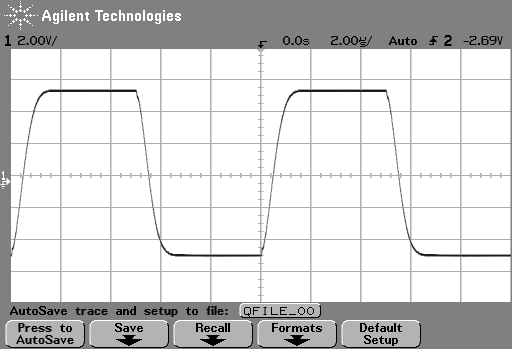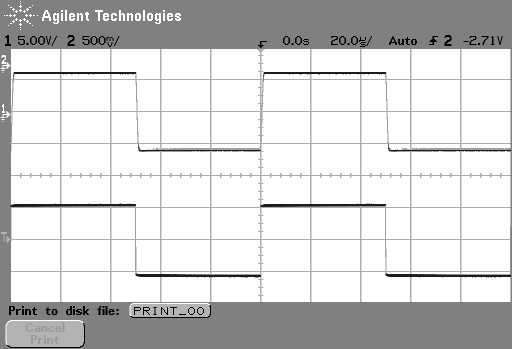I can't see any compensating capacitors. Are they not needed
(drain-gate capacitance may be enough)? If You simulated
that circuit, can You show open loop Bode plots?
PMA asked me if I could post this for him.
Attachments
indeed, a classical and very good topology..
the only drawback i could imagine is the differential input
common gate using irf s...bjts could make the work better..
and the differentials are connected in serial fashion through R1,
thus, the two symetrical stage are serial connected
even in ac mode...
isn t it better to use classical current generators connected
to the relevant supply lines?...
the only drawback i could imagine is the differential input
common gate using irf s...bjts could make the work better..
and the differentials are connected in serial fashion through R1,
thus, the two symetrical stage are serial connected
even in ac mode...
isn t it better to use classical current generators connected
to the relevant supply lines?...
Which amplifier was measured ?I also add the results of measurements


This is because the VCA driver devices have too much capacitance. 100V/us is possible with this design. I have made that number,100V/us, with this topology, for the last 35 years. In other words, the design is 'overcompensated'.
Last edited:
Apparently the actual slew rate should be 60V/us. This should be adequate, but I do think that the mosfets should be smaller in die size, still.
Mr. Curl, measurements posted by Federmann have nothing to do with PMA amplifier . It sholud be "something" created by Federmann according his "revolutionary" principles.
PMA told me that his design has a slew rate of 60V/us and I believe him. It is a more appropriate slew rate for this design.
plk said:Which amplifier was measured ?
Real measurements from PMA "s laboratory, no smoke, no fog, no fantasy 🙄:
http://web.telecom.cz/macura/step_response_pa2.png
Real measurements from PMA "s laboratory, no smoke, no fog, no fantasy 🙄:
http://web.telecom.cz/macura/step_response_pa2.png
SR= 90%-10% Vout
From you grafic Vout=40 V
so: 36-4=32V for 500mSec = 64V/uSec as said John.
Francesco.
SR= 90%-10% Vout
From you grafic Vout=40 V
so: 36-4=32V for 500mSec = 64V/uSec as said John.
Francesco.
500nS not mS, sorry
Sorry, its difference between definitions....
-SR represents the maximum rate of change of a signal at any point... max(abs(dV/dt))
Slew rate - Wikipedia, the free encyclopedia
-90-10% - it may be used for measuring rise or fall time, not SR.
Rise time - Wikipedia, the free encyclopedia
-SR represents the maximum rate of change of a signal at any point... max(abs(dV/dt))
Slew rate - Wikipedia, the free encyclopedia
-90-10% - it may be used for measuring rise or fall time, not SR.
Rise time - Wikipedia, the free encyclopedia
Sorry, its difference between definitions....
-SR represents the maximum rate of change of a signal at any point... max(abs(dV/dt))
Slew rate - Wikipedia, the free encyclopedia
-90-10% - it may be used for measuring rise or fall time, not SR.
Rise time - Wikipedia, the free encyclopedia
agree, but let say that 64V/uS is the mean SR of this amp, as the
(abs(dv/dt)) is the instataneous value...so MOS57 is also right...
Federmann, what you measured in post 61? It is far away from your simulations and it is very poor result. Or you must it heavily compensate, because it was oscilator?🙂
Federmann, what you measured in post 61? It is far away from your simulations and it is very poor result. Or you must it heavily compensate, because it was oscilator?🙂
I know it's not the best result. I used the probe 10:1, and the voltage was greater. As I wrote, yet I can not disclose more.
Hi Pavel,
what do you think about lateral mosfets as output transistors? No regarding measurements but sound quality ?
regards
eD
what do you think about lateral mosfets as output transistors? No regarding measurements but sound quality ?
regards
eD
Hi Pavel,
what do you think about lateral mosfets as output transistors? No regarding measurements but sound quality ?
regards
eD
For what it's worth I can tell you what I think... absolutely the best 🙂
Based on listening to many amps over the years 😉
- Status
- Not open for further replies.
- Home
- Amplifiers
- Solid State
- Solid Solid State Power Amplifier
